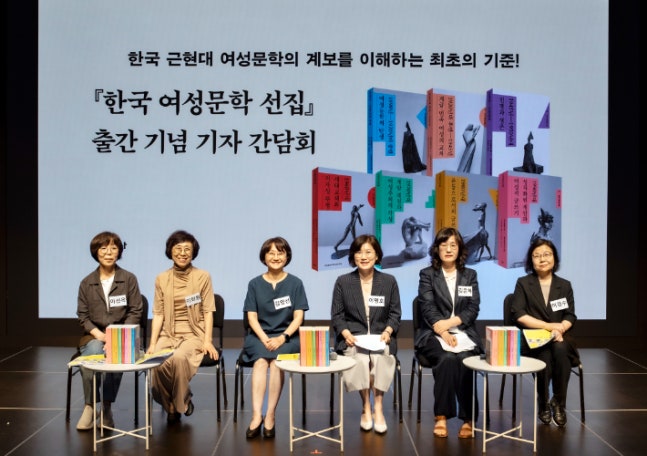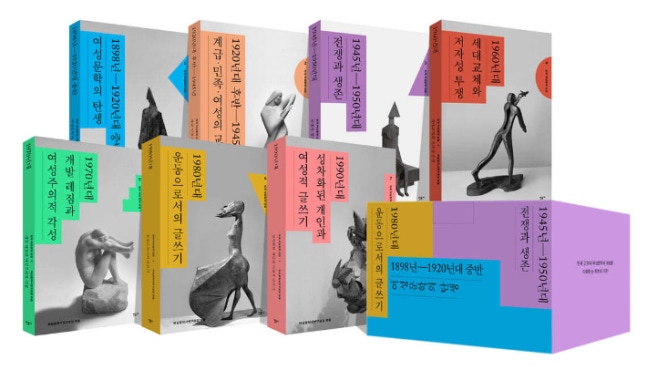Expansion of literature into novels, poems, diaries, declarations, etc.
Establishment point of modern women’s literature: Women’s Rights Declaration of 1898
Emergence of women’s literature at the core since the 1990s,

Participants pose during a press conference held at the NoMuHyun Citizen Center in Jongno-gu, Seoul on the 9th for the publication of the ‘Korean Women’s Literature Anthology’. From left: Lee Seon-ok, Lee Hee-won, Kim Yang-sun, Lee Myeong-ho, Kim Eun-ha, Professor Lee Kyung-soo. Provided by Minumsa , “The ‘Korean Women’s Literature Anthology,’ which is the first compilation of the genealogy of Korean modern and contemporary women’s literature, has been published.”,
,
, “Minumsa and the Women’s Literature History Research Group held a press conference for the publication of the ‘Korean Women’s Literature Anthology’ at the NoMuHyun Citizen Center in Jongno-gu, Seoul on the 9th. They revealed that the anthology, composed of seven volumes spanning a period of 12 years, has compiled the historical transformation of women’s literature that had been marginalized by the national, male, and elite literary centrism in modern Korean literary history and the challenging flow of ‘women’s writing.'”,
,
, “The seven-volume anthology covers from the late Chosun period during the modern enlightenment period to contemporary Korea after democratization in the 1990s, and it includes not only poetry, novels, essays, and plays but also unexplored ‘women’s writing’ that had been outside the institutionalized literary forms such as magazines’ founding essays, declarations, letters, diaries, and labor records, as reasons these have not been dealt with in literary history.”,
,
, ‘Regarding the starting point of modern women\’s literature, Professor Kim Yang-sun stated, “It was important for women to appear in the public sphere. The “School for Women Manifesto” and “Patriotic Song of the Women\’s Association,” published in the first Korean women\’s rights declaration on September 1, 1898 (King Gojong\’s 35th year, Gwangmu 2), created the first chapter in modern women\’s literature as women, breaking free from the past confined to “inner chamber literature,” expressed their voices in the public sphere through writing and Hangul.”‘,
,
, “Unlike the existing literary history that considers 1918, when Na Hye-seok’s ‘Kyunghee’ was published in the women’s education magazine ‘Yeojagye (Women’s World)’ as the origin of women’s literature, this is 20 years earlier. The appearance of authors Kim So-sa and Yi So-sa, who wrote the ‘School for Women Manifesto’ and later established the first women’s school, and the inclusion of Na Hye-seok, Kim Il-yeop, Kim Myung-soon, etc., exactly 20 years later, is a clear point where the direction and method of Korean women’s liberation are revealed.”‘,
,
,

‘Korean Women’s Literature Anthology’ consisting of 7 volumes. Provided by Minumsa ,
, ‘The research group emphasized that they have moved away from genres such as poetry, novels, essays, plays, and moved beyond institutionalized literary forms early on, citing examples from Anglo-American literary studies. Professor Lee Myeong-ho pointed out the importance of the concept of “writing” in literature, which is not only institutionalized writing but also a notion of literature containing self-expression in the form of writing.’,
,
, ‘Further, he added, “Unlike in English literature, which has a small portion of autobiographical literature, it is essential in our literature to authentic’ally express, transform, and reconstruct the inadequate personal stories in historical relationships.”‘,
,
, “In fact, works by Korean-American female authors such as ‘Pachinko’ by Min Jin Lee and ‘Master-Slave Husband-Wife’ by Woo Il-yeon have garnered significant popularity and attention.”,
,
, ‘The group evaluated this anthology as “the first work that summarizes the genealogy of modern and contemporary Korean women\’s literature with women\’s standards and perspectives within the absent existing literary history and simultaneously operates as the first work to archive women\’s knowledge production and writing practice outside the centers of institutional literature.” ‘,
,
, “They added, “In each era, within the oppression that was imposed differently while adapting, resisting, and creating life, the process of transcending eras, contemplating and longing for freedom and women’s liberation can be found in the ‘Korean Women’s Literature Anthology.’ Since the ‘Feminist Reboot’ phenomenon in the 2010s, female readers have increasingly sought books consciously and there has been a growth in academics studying women’s literature. It is expected to serve as a catalyst to make the path of Korean women’s literature richer.”.”,
,
,
- Email : [email protected]
- KakaoTalk : @NoCutNews
- Site : https://url.kr/b71afn

